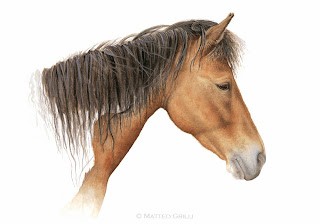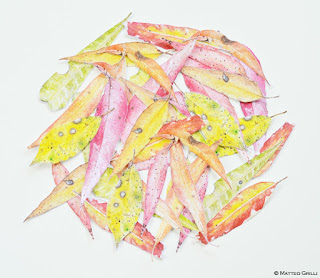In this post I am going to share the account I wrote last year about my experience in reuniting a baby Tawny Frogmouth with its family, hoping it will be helpful for the readers in case they will find themselves in the same situation during the new coming breeding season.
On
October 2012, I noticed a Tawny Frogmouth sitting on a nest
located about six or seven meters from the ground in the park in front of my house.
Not long after noticing the nest I could see the white dawn of the
newly hatched babies. I've been watching the nest every day, enjoying
seeing the baby Tawny Frogmouths growing very quickly. By the size of
the two chicks it was obvious that one was older than the other.
On
November the 9th
I went out at about 5 am and I saw that the nest was empty and one
chick was on the ground at the bottom of the tree. The night before I
saw parent and chicks in the nest just before sunset, so I presume
the eldest chick fledged during the night. At that moment I could not
see any other member of the family. The baby didn't show any sign of
sickness or visible injury. I decided to put it into a box and went to
the local vet who gave me the contact of a local carer and the baby
Tawny Frogmouth eventually ended up with Sandra Bayley, the local
carer specialised in Tawny Frogmouths.
On
November the 10th
I was contacted by Sandra who suggested I tryed to reunite the baby
with its parents on the veranda of my house which faces the park
where the Tawny Frogmouth family lives. Between my house and the park
there is only a street which is usually very quiet. I arranged a
basket on the corner of my veranda tied to the railings and at dusk I placed the baby inside the basket. The baby
appeared to be very active and started begging for food and moved out
from the surrogate nest right onto the railing. My veranda is about
three meters high from the ground and surrounded by a big Jacaranda
tree. Everything I observed was from the inside of my house, through
the closed door and window, I also turned the lights off and closed
the curtains watching only through a small opening between the
curtains to avoid any stress for the parents.
I
put the chick out at around 6.15 pm. The baby started begging
straightaway and within about twenty to thirty minutes one parent
arrived and after checking the situation for a few seconds from the
branch of the Jacaranda tree just in front of the veranda, flew onto
the railing and fed the chick. I believe the parent was the male as
there are some differences between the two parents. The one which
came is a bit bigger than the other as well as less shy in the
presence of humans and grey in colour. The other parent which never
came to visit our veranda is a bit smaller, shyer and has a reddish
tint on the feathers.
I
was able to observe the parent hunting from the surrounding branches
and feeding the chick every ten to twenty minutes. The baby Tawny
Frogmouth never stopped begging and the begging increased as it could
see the parent flying towards the veranda. I noticed that the parent makes a small marble-sized ball of pre-ingested food with sudden movement of its crop and then passes it into the baby's mouth. Feeding occurred in this
manner for a few hours. Around eleven pm there was a break as I could
not see the parent for 45/60 minutes. I went to bed just after
midnight when I last saw the parent coming to feed the baby.
The
morning after, on November the 11th,
I woke up at 4 am and I saw the same parent feeding the chick twice
before the daylight started to increase. While the baby was alone a
couple of Magpies and Noisy miners came and got very close to the
baby and just as I opened the door to put the baby in the box to
prevent it from being harassed, the parent (father) flew over and
perched on the closest branch to the baby. The parents' beak was wide
open and it was clear that it was defending the chick. The other
birds eventually flew away and the parent perched on the railing and
after a few minutes adult and chick were snuggling side by side.
After a few hours for some reason the baby fell just on top of a
potted plant located just below the railing, I decided to get the
chick and put it back on to the railing, the parent didn't seem to be
worried, it just kept staring at me without showing any defensive
behaviour.They spent all day on the railing of our veranda, even when
myself and housemates had to go out and
pass at a distance of 2-3 meters the birds didn't seem to care too much,
they just changed their shape into the branch-like position.
 |
| Father and baby Tawny Frogmouth spending a day on the railing of our veranda. |
At
6.20 pm of November the 11th the parent left the railing and started
hunting and feeding the baby just as the previous night. I watched
the parent feeding the chick every 15 to 20 minutes for about three
hours. At 4 am on November the 12 the parent came to feed the baby a
couple of times within few minutes. The baby was very active and was
flapping its wings energetically until it fell from the railing. The
parent was not around at that moment so I took the baby in my hands
and walked towards the park. I found a low branch and I put the baby
onto it, the baby soon started moving upwards on the branch flapping
its wings and started begging again. Within a couple of minutes
father flew on the tree followed by mother and after a few minutes,
by the eldest sibling. The family was now reunited on the same tree
where they spent the all day.
 |
| The subject of this story is the one on the left, just after reunification with family. |
At
dusk I witnessed the first flight of the young bird I rescued, it was
a very short one, maybe one meter branch to branch. Later at night I
was out again to see the birds, I could hear the baby begging for
food from a very high tree branch and the parent was hunting around.
I was now able to watch very thoroughly the parent (the same that
came to our veranda) hunting as he was not scared by me being there
and the light of the street was providing me with enough light to
see. Still I was not quite sure if the begging chick up in the tree
was the one I rescued or the older sibling. I could not see any other
young or parent around.
The
morning after on November the 13th, at 4.15 am, I was very surprised
to see the young Tawny Frogmouth I rescued already able to fly tree
to tree following the parent to get a feed. I was sure it was the
bird I rescued because I found the older sibling on another tree not
far. Some Noisy Miners and a Grey Butcherbird spotted the fledgling
I rescued and started harassing it, the father came to defend it but
didn't stay for long, the chick was then left alone being pecked by
the angry Butcherbird who repeatedly hit the young Tawny Frogmouth.
The father flew on the tree with the older sibling for the day
roosting. I couldn't do too much as it was rather high on a branch.
The harassing eventually stopped and the fledgling didn't seem to be
much bothered. I had the impression that the parent didn't defend the
young as much as he did on the veranda probably because he knew the
young was now able to fly and could move if it wanted so, but this is
just my thought. The mother flew in and perched on a higher branch
and started calling the baby who flew up and snuggled by her side.
At
dusk, I could observe the parents waking up and starting the hunting
and feeding routine and the babies begging and following the parents
from branch to branch or tree to tree. I could observe this activity
every day at the same time around 6.15-6.30 pm.
The
park in front of my house seems to be their territory, it is just a
few hundred square meters of bush with different-sized trees
generally big and high, there is a small creek and grass and a
playground for kids. The park is packed with wildlife by day as well
as by night.
This is a story of a straight and successful reunification, although not all cases are so straightforward, it is always worth trying reuniting a baby Tawny Frogmouth (or any other wild bird) with its family as its parents will always be the best parents. Human rearing should only be considered if no reunification is possible.
I felt very lucky and privileged to be able to witness such an intimate part of the life of these common but very secretive wild birds right in front of my house.
Fell free to contact me by email matteogrilliart@gmail.com
Here are some tips to help you reunite the baby Tawny Frogmouth with its family:
1. Wait till dusk then take the baby back to the exact place you found it as soon as possible, the parents are probably somewhere close by.
2. Establish if it is safe (no dogs/cats/traffic) to put the bird on a low branch or a post in a sheltered leafy area.
3. At dusk, which is the moment they become active, watch the baby from a distance, it should call out for food and the parents should come and feed it every 15 to 30 minutes for the whole night.
4. If no parent come to feed the baby right away, just leave it out for the night and check if it's with a parent the morning after, if you believe the baby is being left unattended, it needs help, put the baby into a box, contact your local wildlife association, sometimes vets can also be helpful.
5. The best time to check if the family is together is at dusk and before sunrise.
If you found this information useful, I would love to hear your stories, please do not hesitate to contact me, every case is different and sharing information is always important to raise the knowledge. Thank you

















































